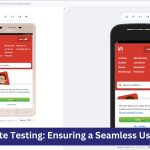Automated testing has come to the fore as an important part of software development to allow organizations to release their software frequently and with high quality and efficiency. Most importantly, in effective automation, there are well-understood test scenarios. When specific test scenarios are written descriptively and consequently, tests will be accurate, unerring, and sustainable. This blog focuses on the role of test scenarios, briefly describes how to utilize them, and shares practical recommendations for effective tests.
What Are Test Scenarios?
A test scenario can be defined as a way of describing what is to be tested at a relatively abstract level. It explains what is to be checked without going down to the detailed procedure. From test scenarios, test cases, and scripts that are used during the automation process.
For example, a test scenario for an e-commerce application might be: “Make sure that payment details are accepted through active checkout by verifying that the users are able to make the purchase with authentic data.”
Test Scenarios vs. Test Cases
- Test Scenario: Focuses on “what to test.” It provides a broad overview of the testing requirement.
- Test Case: Focuses on “how to test.” It includes specific steps, inputs, and expected outcomes.
While test scenarios guide the overall testing objectives, test cases offer granular instructions to achieve those objectives.
Importance of Clear and Actionable Test Scenarios
Ensuring the quality and dependability of software systems requires test scenarios that are both clear and actionable. It makes them a fundamental basis for testing and an ideal compass to assist testers, developers and other stakeholders throughout the SDLC. Below are the key reasons why clear and actionable test scenarios are essential:
- Better Test Coverage: Well-defined scenarios ensure that all critical functionalities are tested.
- Simplified Automation Script Development: Scenarios act as a blueprint, making script writing easier and more systematic.
- Enhanced Collaboration: Scenarios provide a common understanding for developers, testers, and stakeholders.
- Reduced Ambiguity: Clear scenarios minimize misunderstandings and inconsistencies.
- Scalability: Modular test scenarios allow for easier maintenance and scalability as systems evolve.
Key Components of Effective Test Scenarios
Test scenarios play a crucial role in the process of testing since they can help to accomplish a complete evaluation of software applications. The following aspects explain why test scenarios have to be refined:
- Title: A concise name summarizing the test objective.
- Objective: The purpose of the test scenario.
- Preconditions: Conditions, which must be fulfilled before testing is performed.
- Test Steps: Operations to be executed mostly in the form of test steps or test cases.
- Expected Result: The anticipated outcome upon executing the test.
- Dependencies: External conditions or data dependencies needed for testing.
Best Practices for Writing Test Scenarios
Writing effective test scenarios is critical to ensuring thorough software testing. Here are some best practices for creating clear, actionable, and comprehensive test scenarios:
- Keep It Simple and Clear
Do not use industry-specific terms and acronyms. The writing of the scenario should be unambiguous in order to ensure the person who is reading it is able to understand the purpose.
Example: “Verify that users can log in with valid credentials.”
- Focus on End-User Behavior
To make sure the tests are in line with actual usage, write scenarios from the viewpoint of the end user.
For Example: “Make sure users can utilize the ‘Forgot Password’ functionality to reset their password.”
- Prioritize Business Objectives
Focus on scenarios that impact core business functionality, ensuring that critical paths are always tested.
For Example: “Verify that payments are processed securely for all supported payment methods.”
- Include Negative Scenarios
Test how the system behaves with invalid inputs, edge cases, and unexpected conditions.
For Example: “Make sure that people who have an invalid password are unable to log in.”
- Make It Reusable
Develop the scenarios in a manner that will enable one to use them for different test cases or recall them in different projects.
For Example: “Check if users are able to add products to their carts. can be applied to situations when order confirmation and checkout are involved.”
- Use Proper Naming Conventions
Follow consistent naming patterns to make scenarios easy to organize and identify.
For Example: Login_Success and Login_Failure_InvalidPassword
- Incorporate Data-Driven Testing
Wherever possible, write scenarios to support data-driven testing for scalability.
For Example: “Verify checkout process for multiple payment methods: Credit Card, PayPal, and Net Banking.”
- Leverage Tools and Frameworks
Utilize test management tools to organize and manage scenarios effectively. Cloud-based testing platforms such as LambdaTest enable cross-browser and cross-platform testing, ensuring compatibility across different environments. With LambdaTest, teams can execute automated tests at scale, leveraging parallel execution capabilities to accelerate testing cycles.
Moreover, LambdaTest supports integrations with popular CI/CD tools, enabling seamless collaboration and continuous testing throughout the development pipeline. Its real-time testing features and automated screenshot comparisons help teams quickly identify visual inconsistencies, ensuring a smooth user experience across different devices and browsers. These features play a vital role in maintaining high standards of quality assurance, enabling teams to deliver reliable and consistent software solutions.
Examples of Test Scenarios for Automation
Test automation is best suited for simple, repeatable test cases and regression testing, as well as situations when testing is required in various environments. The following are other testing examples that lend themselves to automation:
- Login Functionality
- Scenario: Ensure that the login page checks for the correct password and username then offers the user access to the account details.
- Automation Test: Provide a valid username and password, click the login button and check whether the user is taken to the home page or not.
- Form Validation
- Scenario: Ensure that for the fields marked as required, the form gives an error message when no input is entered.
- Automation Test: Leave the fields in the form without inputs and fill up the form, then check whether the relevant error message is shown.
- Search Functionality
- Scenario: Verify that the search bar returns the correct results based on the entered keywords.
- Automation Test: Enter different search terms and verify that the results are relevant to the keywords entered.
- User Registration
- Scenario: Validate that a new user can successfully register an account.
- Automation Test: Fill out the registration form with valid details, submit the form, verify the success message and redirect to the login page.
- Password Reset
- Scenario: Perform a password reset test to make sure that the user is able to reset his password.
- Automation Test: Go to the login page, select the “Forgot Password” option, input a valid registered email address then verify the password reset link(campaign).
- Payment Gateway Integration
- Scenario: Verify that the payment gateway correctly processes payments and returns a confirmation.
- Automation Test: Provide valid payment details, process the payment, and validate that the confirmation message or receipt is generated.
- UI Element Visibility
- Scenario: When testing the web page, it is necessary to check that all essential UI controls (buttons, links, forms) are placed on the Web site and easily distinguishable together with being clickable.
- Automation Test: Verify that essential UI elements are displayed and can be interacted with on the page.
- Database Record Update
- Scenario: Verify that user data is correctly updated in the database after submitting changes through the application.
- Automation Test: Submit changes through the UI and validate the corresponding updates in the database using automated scripts.
These examples highlight scenarios that involve consistent, repeatable actions where automation can save time, reduce human error, and improve testing efficiency.
Challenges in Writing Test Scenarios
Writing effective test scenarios can be complex and requires attention to detail. Several challenges may arise during the process, including:
- Ambiguity in Requirements: Lack of clarity can lead to incomplete scenarios.
- Frequent Changes: Agile environments often require scenarios to be updated frequently.
- Data Dependencies: Managing test data for different scenarios can be complex.
- Automation Tool Limitations: Some scenarios may require manual intervention, limiting automation.
Overcoming Challenges
It’s critical to use techniques that increase efficiency, coverage, and clarity in order to overcome the typical difficulties encountered when developing test scenarios. Here are a few strategies to deal with the difficulties:
- Collaborate with stakeholders: To elaborate requirements, stakeholders that should be engaged are; product owners, developers and business analysts.
- Version Control: Record change and modification history by using version control systems.
- Data Management Tools: To handle dependencies, make use of data management frameworks.
- Hybrid Approach: For difficult-to-automate scenarios, combine automated and manual testing.
Evaluating the Effectiveness of Test Scenarios
Coordinating between the test scenarios and examining them as to how useful they are for testing is very important since it can determine the test results. A good test strategy assists in detecting flaws before the product is released and makes sure the software will fulfil its purpose. Below are key strategies to evaluate the effectiveness of test scenarios:
- Coverage of Requirements
Evaluation: It is important to note whether the above test scenarios incorporate both the functional and the non-functional requirements of the software. Each feature, user interaction, and edge case should be included in the scenarios.
Tip: Use a traceability matrix to map test scenarios to the specific requirements they validate, ensuring full coverage.
- Clarity and Understandability
Evaluation: Determine if these test scenarios are written in plain language, which both testers and non-testers are able to comprehend without a hitch. Test scenarios should be easy to follow and actionable.
Tip: Have a peer or a stakeholder review the test scenarios to confirm that they are unambiguous and easy to execute.
- Relevance and Focus
Evaluation: Review whether the test scenarios focus on the critical features and potential risks of the software. Ensure that scenarios are not overly broad or overly narrow but targeted to validate the most important aspects.
Tip: Ensure that test scenarios are ranked with business priority and risk to ensure that high business priority features are aptly tested.
- Balance Between Positive and Negative Scenarios
Evaluation: Get feedback on the current testing criteria to ensure there is a healthy rate of positive testing (valid input cases) versus negative cases (invalid or boundary inputs). Both are necessary to ensure the software handles a variety of use cases.
Tip: Make certain that test scenarios not only check the correct operation in a preconceived way but also check how the system reacts to incorrect data.
- Test Data Coverage
Evaluation: Analyze whether the test scenarios account for various types of test data, including boundary values, edge cases, and random data. It helps identify potential vulnerabilities and unexpected behavior.
Tip: Use boundary value analysis and equivalence partitioning to generate diverse test data scenarios.
- Reusability and Maintainability
Evaluation: Determine whether the test scenarios define the flexibility and maintainability of the tests. This is especially the case in automated testing because test scenarios should be easily modified as the application changes.
Tip: Take the test scripts to be created in a modular form so that these test scenarios can be reusable in other situations, especially in regression testing.
- Execution and Results
Evaluation: Run the test scenarios in different environments (such as multiple browsers or devices) and verify that they consistently deliver the expected results. Test scenarios should be stable and reliable, with minimal need for manual intervention.
Tip: Track the results of each test scenario and ensure that failures are documented with clear steps to reproduce and diagnose.
Conclusion
Writing clear and actionable test scenarios is a cornerstone of effective test automation and high-quality software development. These scenarios not only guide the testing process but also enhance collaboration between teams, improve test coverage, and ensure that testing aligns with business goals.
By focusing on simplicity, clarity, and reusability, teams can create scalable and maintainable tests that evolve with the software. Incorporating best practices such as prioritizing end-user behavior, addressing edge cases, and leveraging data-driven testing further strengthens the testing framework.
Despite the challenges that may arise—such as ambiguous requirements or frequent changes—adopting tools, frameworks, and structured approaches can streamline scenario creation and execution. Evaluating test scenarios regularly using metrics like coverage, relevance, and execution reliability ensures continuous improvement.



